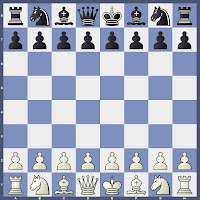A fine positional skirmish....as a knife slits the apple...painlessly! - Aeroflot Round - 4
Boris Gelfand - Lu Shanglei; Aeroflot - 2016
1.d4 d5; 2.c4 e6; 3.Nf3 Nf6
Only three moves are over....and what is so interesting about this position....one might wonder!?
The same position would have appeared tens of thousands of times over the board...over the years.....and.....
......it also occurred in a fine game played by the World Champion Anatoly Karpov against another World Champion Boris Spassky 37 years ago....but in a different order! So what!?
Karpov wrote:
"During the last few decades, opening theory has made great strides forward. A thorough study has been made not only of all possible opening schemes, but, and this is particularly important, the order in which they are played. Often during the first few minutes of play, grandmasters hold a sort of silent dialogue with each other. And that is the case here. Only three moves have been made, and already much of importance has been said! Schematically, this appears as follows:
Spassky: (after 1.d4 Nf6; 2.c4 e6) "A Nimzo-Indian Defence would suit me"
Karpov: (3.Nf3): "There is probably not much point in allowing Spassky to play the Nimzo-Indian; he has too much experience in this opening. I'll suggest a Queen's Indian."
Spassky: (3.....d5) "I'd prefer a Queen's Gambit or a Catalan Opening.'
Not sure if this is what happens over the board today....I mean not the dialogue per se, but the inner deliberations on what to play on that day, over the board....and thoughts about trying to outfox the opponent either through an unexpected choice of opening or unexpected continuation in a opening....till the time the opening phase is completed!
I guess, today it will be more about trying to remember the move that is stored in the HD in a CBV file under the label "ZZZAB1".....amidst endless forest of variations and moves.....which might perhaps outnumber the 'pests' that are existing in a particular area of a real forest!
But, Boris is from the classical school and might be engaging himself in a similar dialogue....if not in this game, when he plays against his peer group!
4.g3 dc4; 5.Bg2 c5; 6.OO Nc6; 7.Qa4 Bd7; 8.Qc4 b5; 9.Qc3 cd4; 10.Nd4 Nd4; 11.Qd4
By now, I believe a new position has arrived on the board....at least as per my database. A cursory look at the position would reveal that though both sides are yet to complete their development, White as of now controls more squares in the center in a hypermodern way and would soon decide on what to do with his Queenside pieces. Whilst Black has to solve the problem of where to put his dark squared Bishop, especially in view of the fact that he has already weakened the dark squares on the Queenside. White's light squared Bishop is finely placed than his counterpart.
The position is in a state of equilibrium despite the minor pluses that White enjoys....which is as per nature's law!
I looked at some games in this opening to try and understand what is happening, and came across a particularly difficult one played by Kortchnoi against Karpov in their candidates match in 1974 and despite enjoying a slight advantage, Kortchnoi wilted suddenly to handover the little plus and even ended up worse through a glaring mistake and lost.
I also came across another interesting game played by Kortchnoi against Ivanchuk in 2000 and fell in love at the following position.....if not for anything, the sheer beauty of finding four beasts standing besides each other and that too in that all important four central squares!!
Chess is immensely and infinitely beautiful....only that we need to have our eyes and ears open....to see and hear!!?
Korchnoi again landed in trouble soon....Ivanchuk played beautifully, sacrificing an exchange to create an exquisite finish!
Coming back to the game.....
11.....Rc8; 12.Bf4 Bc5;
Somehow, this square doesn't look like a natural square for this Bishop in this position....though it is required to be developed there to defend the a-pawn and with his next move Black temporarily keeps a pressure on f2.
13.Qd3 Qb6; 14.Nd2! OO; 15.Ne4! Bc6
Of course, 15......Ne4 concedes a pawn to double attack after 16.Be4! Now White has achieved something out of the opening...by fracturing the Black's Kingside pawns and obtaining the control of dark squares around it, in particular!
16.Nf6 gf6; 17.Bc6!?
How else can White free his f1-Rook from just being a mere guard of a soldier!
17.....Qc6; 18.Rfd1 Bb6; 19.Rac1 Qb7; 20.Rc8 Rc8; 21.Bh6!
Optically and actually White stands better now! Could Black have avoided this!?
Possibly, he could have played his King to g7 while White was taking control of the d-file with his Rfd1! Chess results hinges on accumulation of such minor details....!
21......b4; 22.e4! Kh8
The move 22.e4 was played with the intention of moving his Queen to g4 via f3 and deliver a mate!
23.Qd7 Qd7; 24.Rd7 Kg8; 25.Rb7!?
A mysterious move which prevents Black from playing .....Bf8!
25.....Bc5; 26.b3 Ra8; 27.Rb5 Be7; 28.Kf1! a5; 29.Bf4!
Now that Black has readied his Queenside so as to allow himself of .....Bf8, White redirects his attention to the weakened Queenside pawns!
29.....Bd8; 30.Ke2 Kf8; 31.Kd3 Rc8; 32.Be3 Rc3; 33.Kd2 Ke7; 34.Bd4 Rc6; 35.f4 Rd6; 36.Ke3 Rc6; 37.Kd2 Rd6; 38.Kd3 Kd7! 39.Kc4 Rc6; 40.Rc5 Be7?!
Perhaps 40.....f5 removing one pawn from the dark square may have been the way. But defending such an ending can be very painful over the board. The defending side slowly would run out of moves and reach a zugzwang.
41.Rc6 Kc6; 42.f5 Bd8; 43.Bc5 h5; 44.Bf8! Kb6; 45.Bd6! Kc6; 46.Bc5! 1 - 0
A typical Gelfand execution! Such games goes through your mind like a fine vintage scotch through your throat! Yet, the process of rendering it finer is both exquisite and complex!






.jpg)
.jpg)

Comments
Post a Comment